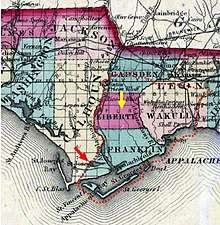St. Joseph, Gulf County, Florida
St. Joseph was a boomtown that briefly became the largest community in Florida, before being abandoned less than eight years after it was founded. St. Joseph was founded in 1835 on the shores of St. Joseph Bay, one of the finest natural harbors on the Gulf Coast of the United States. A brief period of prosperity was ended by a yellow fever epidemic in 1841, and the abandoned remnants of the town were destroyed by a storm surge in 1844. The townsite is in Gulf County, Florida, near the city of Port St. Joe.
Background

The creation of St. Joseph grew out of a land dispute in Apalachicola, Florida. Early in the 19th century John Forbes and Company, a Scottish-owned trading company authorized by the Spanish government of Florida to trade with Indians, had pressured Creeks and Seminoles to settle their debts with the company by transferring title to large tracts of land in Florida. The transfers were confirmed as grants by the Spanish government. The biggest block of land, amounting to 1,200,000 acres (490,000 ha) between the St. Marks and Apalachicola Rivers, became known as the Forbes Purchase, or Forbes Grant. The partners of John Forbes and Company sold most of the Forbes Purchase to what later became the Apalachicola Land Company before the transfer of Florida from Spain to the United States in 1821.[1]
Establishment of the legitimacy of Spanish land grants in Florida often required action in the federal courts. By the time that ownership of the Forbes Purchase by the Apalachicola Land Company had been confirmed in court in 1835, the town of Apalachicola had grown up on the west side of the mouth of the Apalachicola River. The land company offered to sell title to the occupied lots in town, but at prices that drove many residents to abandon their homes and move west to the shores of St. Joseph Bay.[2]
History
St. Joseph was founded in 1835. As no rivers flowed into St. Joseph Bay, the Lake Wimico and St. Joseph Canal and Railroad Company was built connecting St. Joseph with the Apalachicola River in an attempt to siphon off some of the cotton and lumber being shipped down the river to the port of Apalachicola.[3]
By 1837 St. Joseph had become the most populous place in the Territory of Florida, with approximately 6,000 inhabitants. In 1838 the town hosted the first Constitutional Convention for Florida, which drew up the constitution used when Florida became a state in 1845.
Storms in 1837 (1837 Racer's hurricane) and 1839 drove ships ashore and destroyed buildings. In 1841 a ship brought yellow fever to St. Joseph. The disease killed many of the town's inhabitants, and caused most of the rest to flee. Of an estimated 5,000 inhabitants in early 1841, only some 500 remained in St. Joseph after the epidemic ended. A hurricane, "The Late Gale at St. Joseph" hit the town on September 14, 1841, destroying the wharf, but no ships were in port. A forest fire later that year burned part of the town. In 1843 residents of Apalachicola moved many abandoned houses to Apalachicola. In 1844, a hurricane crossed the Florida peninsula into the Gulf of Mexico and then turned north, striking St. Joseph on September 9 with a large storm surge, destroying the abandoned town.[3]
The area remained uninhabited for the rest of the 19th century. In the early 20th century Port St. Joe was founded about two miles north of the site of old St. Joseph.
Present day
The only remains of St. Joseph are some tombstones in the Old St. Joseph, or 'Yellow Fever', Cemetery in present-day Port St. Joe - coincidentally located very close to the current office of the county health department.
The Constitution Convention Museum State Park nearby explains the role of St. Joseph in the early history of Florida government.
See also
Notes
- ↑ Upchurch, John C. (October, 1969). "Aspects of the Development and Exploration of the Forbes Purchase". The Florida Historical Quarterly. 48 (2): 117–139 – via JSTOR. Check date values in:
|date=(help) - ↑ Turner, Gregg M. (2008). A Journey into Florida Railroad History. Gainesville, Florida: University Press of Florida. p. 37. ISBN 978-0-8130-4194-0.
- 1 2 Jones, Herman (September 8, 2016). "Death's Angel: The 'Great Tide' of 1844". The (Port St. Joe) Star. Retrieved October 12, 2018.
References
- McCarthy, Kevin M. (1990). Florida Lighthouses, Paintings by William L. Trotter, Gainesville, Florida: University of Florida Press. ISBN 0-8130-0982-0.
- St. Joseph, Florida Ghost Town - retrieved February 17, 2006
- Lighthouse Friends - St. Joseph Point, FL - retrieved February 17, 2006
- Old St. Joseph Cemetery a/k/a Yellow Fever Cemetery - retrieved February 17, 2006
Further reading
- Louise Porter. Lives of St. Joseph. St Joseph Historical Society (Dec 2001) ISBN 0-9636228-2-X
